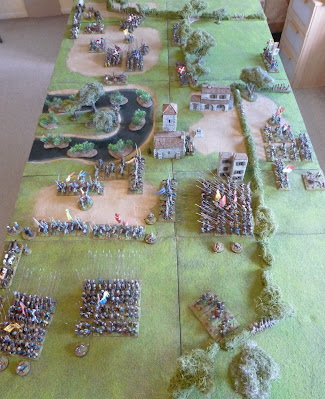Novara, 1513
The bloody French victory at Ravenna in April 1512 served only to harden the attitudes of the Holy League, making the League ever more determined to oust Louis XII's troops from Italy. With anti-French sentiment rising the Swiss cantons sided with Spain and the Papacy. A Swiss army invaded the Duchy of Milan and by July of 1512 the French under La Palice had abandoned the duchy with only the citadels within Milan, Cremona and Brescia remaining in the hands of French garrisons. As a compromise between the various leaders of the Holy League Maximilian Sforza was made Duke of Milan at the close of 1512, in reality being little more than a puppet of the Swiss.
The spring of 1513 saw the French King Louis XII attempt to recover the prized duchy with an army crossing the Alps under the veteran French captain Louis II de la Trémoille and Milanese born condottieri Gian Giacomo Trivulzio. The French numbered 1,200 to 1,400 lances, 600 light horse and 11,500 infantry, including 6,000 landsknecht, being strengthened by a contingent of 2,500 Italians once they had crossed into Italy. Sforza's hold on Milan began to collapse with the French taking the west of the duchy. Maximilian Sforza himself was in Novara which La Trémoille began to besiege only to withdraw his forces on 5 June when 7,000 to 8,000 Swiss reinforcements were sent to aid the city.
Initially, as the French had not travelled far from the city, La Trémoille showed caution, keeping his men under arms. He then decided the Swiss were not going to pursue his retreating army that night and his army made camp around the village of Trecate. The cavalry were to one side of the village with the infantry and artillery to the other. He had no idea the Swiss relief force would unite with the 4,000 Swiss already in Novara and march out to attack them before dawn! Accompanying the Swiss pike were Maximilian Sforza's retinue of 200 horse and around 8 light guns.
In terrain broken up by irrigation ditches and hedges the Swiss stormed through the fire of the hastily readied French artillery. They fell upon the French infantry clashing with the 6,000 landsknecht in French employ under the command of Robert III, de la Marck who was said to have sustained over 40 wounds in the clash. La Marck was rescued by his father, Robert II, Duke of Bouillon, who was also seriously wounded, at the head of his gendarme company. The landsknecht were overrun with the French and Italian infantry routing. Being some distance from the infantry the French cavalry, save for those under the Duke of Bouillon, made little attempt to aid the infantry abandoning their baggage to the Swiss whilst they escaped the field. This was to be the last great victory of the Swiss using their combination of surprise and disciplined battle formations.
 |
| The French army around the village of Trecate. The cavalry under Louis II de la Trémoille are in the foreground with the infantry under Robert III, de la Marck, in the distance. |
 |
| A view of the French deployment from above. The swampy terrain between the infantry and cavalry can be seen in the centre left of the picture. |
Scenario
For this game we wanted to try and recreate the surprise nature of the Swiss attack. We both took one of the French retinues, comprising either the infantry and artillery or the cavalry. To add to the confusion we also had a cavalry or infantry unit or units in the other players deployment area. This was to try and represent the fact that the infantry had been disorganised and that within the cavalry element of the army the Duke of Bouillon had been able to lead his gendarmes in support his son when the rest of the cavalry had decided they would not engage.
There was difficult terrain between the two retinues which can be seen in the photos as a swampy area behind the village of Trecate.
The Swiss
As always we played the game using our modified "Renaissance Rampant" rules but we added additional rules for the Swiss who we were both playing against. Part of the Swiss force, the pike blocks, would act automatically whilst Tom and myself would play a card each turn to see which of us would control the supporting units.
As always we played the game using our modified "Renaissance Rampant" rules but we added additional rules for the Swiss who we were both playing against. Part of the Swiss force, the pike blocks, would act automatically whilst Tom and myself would play a card each turn to see which of us would control the supporting units.
Surprise Attack
The Swiss forces started the game off table and took the first turn. A move activation roll had to be made for each of the 3 pike blocks in turn. Each time one succeeded they would arrive on one of three of the table edges, which were generated randomly. A D6 roll of 1-2 meant they arrived on the French right, 3-4 the centre and 5-6 the French left. We diced for what part of that table edge they then arrived on. If one of the pike blocks failed the activation the Swiss turn moved onto the supporting units and on the next Swiss turn we then diced again to see whether any remaining pike units entered the table.
The supporting units were controlled by one of us and they could be brought on via move activations. Once a successful move activation was made they could be brought onto the table. They had to be brought on within 16" of one of the pike blocks or as near as possible to one of the pike blocks if the blocks were already well into the field. No supporting units could be brought on until at least one pike block had entered the field.
The Pike Blocks
The main part of the Swiss army comprised of 3 large pike blocks representing the Vorhut, Gewalthut and Nachhut.
For the game they had standard Swiss pike block profiles from our "Renaissance Rampant" rules but they had far more "hits" than the standard 12 for an infantry unit. The Vorhut, had 24 "hits", with the first 4 having armour of 3. This meant that once 4 "hits" had been taken the unit's armour would go down to 2. The Gewalthut had 20 "hits" with the first 4 having armour of 3. Finally the Nachhut had 18 "hits" with the first 3 having armour of 3.
The pike blocks did not start testing for morale until they had reached 12 hits and then they tested for morale as any other unit. They fought with 12 dice until they fell below 6 hits.
Once on the table at the start of each turn the pike blocks would always move towards, and attack if possible, the nearest enemy unit to their front, heading for the nearest large body of troops. If either of the French retinue leaders were within attacking range they would prioritise them over other units. Any contentious decisions over which unit they would attack were resolved by a dice roll. The pike were not required to take activation tests but would move every turn (unless they had less than 12 "hits" left and had failed a courage test).
The supporting units
The pike blocks were supported by a number of supporting units such as arquebusiers, a captain and halberdiers. It turns out that in the actual game these units offered very little support!
After the pike blocks had moved we would play a card for control of the supporting units. We started the game with a hand of 5 playing cards each. Each turn we would play a card and whoever played the highest card got to control the Swiss supporting units for that turn. These units behaved like a normal retinue and a failed activation would end their turn. We would both then take another card ready for the next round. The supporting units could not be used to block the pike blocks in their advance towards the main armies. If they were placed in front of the main blocks they would just be moved to the side when the blocks move forward.
Victory Points
We were both on the same side for this game and competing against each other as the respective commanders of the French infantry and cavalry. Victory went to the retinue with the highest victory points score.
These were awarded as follows:
These were awarded as follows:
6 points to the player whose unit was the one that dealt the final blow to the Vorhut causing it to be removed from the table.
4 points to the player whose unit was the one that dealt the final blow to the Gewalthut causing it to be removed from the table
3 points to the player whose unit was the one that dealt the final blow to the Nachhut causing it to be removed from the table
4 points if a player killed Maximilian Sforza, Duke of Milan
1 point if a player killed the Swiss Captain
2 points to the infantry player if Robert III, de la Marck survived
2 points to the infantry player if Robert II, Duke of Bouillon survived
2 points to the cavalry player if Louis II de la Trémoille survived
2 points to the cavalry player if Gian Giacomo Trivulzio survived
 |
| The French infantry comprising French, Italians and landsknecht under Robert III, de la Marck. |
 |
| Landsknecht, French crossbowmen and Italian infantry hastily prepare to face the oncoming Swiss as dawn breaks. |
 |
| The French cavalry under Louis II de la Trémoille and the condottieri Gian Giacomo Trivulzio. |
The Armies
For this game Tom chose to take control of the infantry under Robert III, de la Marck, so I took the cavalry under Louis II de la Trémoille. As described above once on the table the Swiss pike would activate automatically whilst we would play a card to see who controlled the supporting units.
For this game Tom chose to take control of the infantry under Robert III, de la Marck, so I took the cavalry under Louis II de la Trémoille. As described above once on the table the Swiss pike would activate automatically whilst we would play a card to see who controlled the supporting units.
The Swiss (or nominally Milanese) Army
The Pike Blocks
The Vorhut - A pike block with 24 hits (4 of which have armour 3)
The Gewalthut - A pike block with 20 hits (4 of which have armour 3)
The Nachhut - A pike block with 18 hits (3 of which have armour 3)
The Supporting Units
1 Unit of Foot Knights - The Swiss Captain (who would count as retinue leader for morale purposes and could issue challenges)
1 Unit of Gendarmes - Maximilian Sforza, Duke of Milan (Sforza's gendarmes did not have wild charge in this game)
2 Units of Swiss Arquebusiers
2 Units of Swiss Halberdiers
1 Culverin
1 Unit of Gendarmes - Maximilian Sforza, Duke of Milan (Sforza's gendarmes did not have wild charge in this game)
2 Units of Swiss Arquebusiers
2 Units of Swiss Halberdiers
1 Culverin
The French
Louis II de la Trémoille and the French Cavalry
1 Unit of Gendarmes - Retinue Leader, Louis II de la Trémoille
1 Unit of Gendarmes - Gian Giacomo Trivulzio
2 Units of Men at Arms
2 Units of Ordonnance Archers with lance
1 Unit of Stradiots
1 Unit of Mounted Crossbowmen
2 Units of Italian Infantry - These were deployed within the infantry deployment zone and not with the cavalry.
Robert III, de la Marck and the infantry
1 Unit of Landsknecht Halberdiers - Retinue leader Robert III, de la Marck
3 Units of Landsknecht Pike
1 Unit of Landsknecht Arquebusiers
2 Units of Aventuriers
2 Culverins
1 Unit of Gendarmes, Robert II, Duke of Bouillon , who was deployed within the cavalry deployment zone and not with the infantry.
A brief write up of the game follows below, as always the captions under the photos are a good way to see how it developed. The surprise nature of where the Swiss would attack meant that the outcome of the game differed wildly from the actual battle!
 |
| The Swiss Gewalthut is first to strike, rapidly advancing out of the fields and arriving on the right of the French cavalry. |
 |
| In the centre of the field the largest block in the form of the Vorhut arrives and also looks to be aiming at the French horse. |
 |
| Buying time for their comrades a unit of French lancers charges the Gewalthut. These lighter cavalry are scattered by the oncoming pikemen. |
 |
| As the Nachhut arrives to support the Gewalthut, , Robert II, Duke of Bouillon leads his gendarmes into the Swiss pike. |
From the start we realised this refight was going to be nothing like the actual battle of Novara! With a blaring of horns and roll of drums the Swiss Gewalthut emerged out of the morning haze on the French armies right flank and made straight for the cavalry. In front of the French army, heading directly from Milan, the massive Swiss Vorhut appeared, again making for the French horse. A unit of French "archers" with lances charged into the Gewalthut and were defeated immediately, fleeing from the field. Minutes later the final pike block in the form of the Nachhut arrived in support of the Gewalthut. All of the Swiss pike had committed themselves to an attack on Trémoille's mounted contingent of the French army.
Following the French "archers" Robert II, Duke of Bouillon, father of the captain of the French infantry, La Marck, led his company of gendarmes into the Gewalthut. He managed to cause casualties to the dense body of infantry and wheeling back prepared his men for another charge. To his dismay the Duke of Bouillon was also being threatened by the Nachhut. In a series of charges and countercharges the Duke and his men were slain, although they had managed to weaken both of the Swiss pike blocks they faced.
On the other side of the field, unaware of the fate of his father, La Marck began to move the French infantry in an attempt to engage the Swiss. One of the units of Italian troops deserted in the confusion and La Marck struggled to redeploy the landsknecht and aventuriers under his command. In the centre of the field the Swiss Vorhut was followed up by smaller units of Swiss arquebusiers and halberdiers whilst the banner of the Duke of Milan could be seen flying over a small unit of gendarmes to the rear of the Swiss army.
 |
| The Gewalthut battles with the Duke of Bouillon and his men. |
 |
| Unsupported by the rest of the French horse the Duke of Bouillon courageously holds up two of the Swiss pike blocks. |
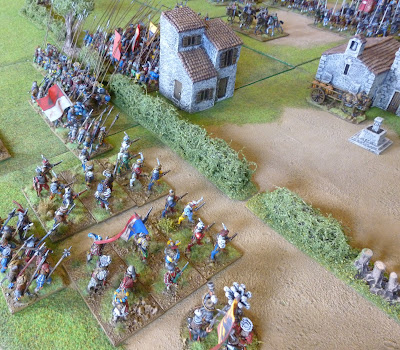 |
| In the centre the Swiss captain arrives with arquebusiers and halberdiers to support the Vorhut. |
 |
| The battle develops with all of the fighting being on the French right where the cantonal forces have targeted Trémoille's cavalry. |
 |
| The Vorhut crosses the hedges that have shielded their surprise attack. |
 |
| The Swiss Vorhut with arquebusiers and halberdiers behind it. |
 |
| The French cavalry are hit in the flank by the Gewalthut and Nachhut. |
 |
| One of the Italian infantry units comprising part of the infantry force on the French left flank decides to desert during the chaos of the surprise attack. |
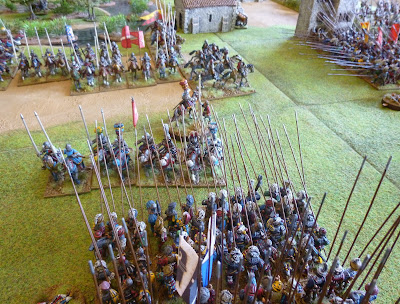 |
| After putting up a brave fight against overwhelming odds the Duke of Bouillon and his gendarmes are defeated and slain. |
 |
| An overview of the Swiss attack with all three of the pike blocks converging to hit the French cavalry. |
 |
| The mounted crossbowmen hastily retreat in front of the oncoming pikes. |
 |
| French men at arms prepare to charge the Swiss Vorhut. |
 |
| The French horse are attacked from the front and the flank. |
 |
| Trémoille's cavalry are about to be hit on two sides. |
 |
| A view from above showing the pike blocks bearing down on the cavalry. |
 |
| The Vorhut advances. |
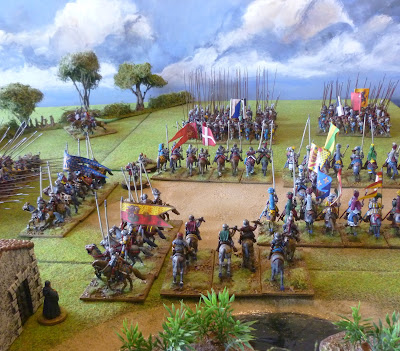 |
| The French cavalry prepare to charge the advancing Swiss. |
 |
| On the other side of the field La Marck attempts to move his infantry into a position to engage the Swiss. |
 |
| Trivulzio's gendarmes charge into the Swiss. |
The sacrifice of the Duke of Bouillon and his men had bought time for La Trémoille and Trivulzio's horsemen. Their gendarmes on barded steeds and only slightly lighter armoured men at arms led charge after charge into the Swiss blocks as they marched forward. The stradiots in French service managed to get behind the Gewalthut from where they could launch damaging skirmish attacks on the mass of pikemen.
Unfortunately for the Swiss their supporting units of arquebusiers and halberdiers halted in front of the village of Trecate with the French guns taking pot shots at them from long range. This lack of support meant that the elite French heavy cavalry, supported by their stradiots and mounted crossbowmen were able to blunt the Swiss attack, at first halting the Swiss pike blocks and then pushing them back. The Gewalthut, which had been the first to arrive, withdrew after repeated charges from Trivulzio's heavy horse with the stradiots attacking the rear of the unit. This began a domino affect as moments later the smaller Nachhut retreated.
The Vorhut, the biggest of the Swiss pike formations, was left isolated with its smaller pike units having been defeated and its support troops failing to commit to the fight. The mauled French cavalry were able to quickly reform and strike at the remaining pike block, whilst the Stradiots attacked it in the flank. As the Vorhut withdrew the Swiss captain called a general retreat and the smaller Swiss units of arquebusiers and halberdiers left the field having played no part in the fighting.
La Marck had managed to bring his forces up to defend the hedgerow but far from bearing the brunt of the fight and sustaining over 40 wounds as had happened in the actual battle his infantry had not engaged at all. He spotted a dismayed Maximilian Sforza, the Duke of Milan, with his cavalry bodyguard on the field but Sforza was quick to flee once a hail of bolts had been launched at him from the French crossbowmen. The battle was over. Remarkably the French gendarmes supported by their lighter armoured cavalry and stradiots were able to take on the Swiss pike blocks and defeat them without the support of their infantry.
This was a really interesting game and Tom and I were both surprised with the result. We had wanted the surprise element of the Swiss attack to be a big factor in the game and this certainly proved to be the case! The Swiss focused purely on the French cavalry contingent instead of engaging with the landsknecht and artillery as they had done in the actual battle. This made the outcome of the battle radically different as the constant charges by the French gendarmes and men at arms combined with the skirmish attacks of the stradiots were sufficient to stop the pike blocks. This was in spite of the fact the Swiss pike blocks had so many "hits" and were so effective in combat.
If the supporting Swiss halberdier and arquebusier units had been able to close with the French, not to mention the "Foot Knight" Swiss captain unit and Sforza's gendarmes then the outcome would have be very different and the French cavalry would undoubtedly have been wiped out. I had won control of the Swiss support units on the second turn of the game and managed to deploy them all as far from my cavalry units as possible and this had a big impact as they were simply unable to get into action. When I commanded them I kept them inactive so I could deal with the pikes whilst when Tom got command of them they kept failing to activate! We decided that if we refought this we would change the rules so that each of the blocks, the Vorhut, Gewalthut and Nachhut, had specific units associated with them that would actually support them in the game. This would have made a big difference.
So in the end it was an overwhelming and very unhistorical victory for the French cavalry under Louis II de la Trémoille. The only person who had lived up to his performance in the real engagement was the Duke of Bouillon but instead of riding to rescue his son as happened at Novara, in this game it was his gendarmes who were the first to wild charge into the oncoming Swiss and sell themselves dearly in the process. The rules for the pike blocks were a lot of fun and despite the fact Tom's infantry never engaged we were both constantly involved in the game as we battled to control the Swiss units.
We will definiteley continue this "Renaissance Rampant" experimentation with the big pike formations. I love the look of the dense blocks of pikemen on the table and when the specific Reisläufer bases are mixed in with the landsknecht (which I need to do to make up the numbers of these huge blocks) the units still have a very Swiss feel to them under the Cantonal banners with all the white crosses and ostrich plumes. They made for a great game, very much full of surprises, and one fit for the 200th Camisado post. Now lets see if we can reach 300...
La Marck had managed to bring his forces up to defend the hedgerow but far from bearing the brunt of the fight and sustaining over 40 wounds as had happened in the actual battle his infantry had not engaged at all. He spotted a dismayed Maximilian Sforza, the Duke of Milan, with his cavalry bodyguard on the field but Sforza was quick to flee once a hail of bolts had been launched at him from the French crossbowmen. The battle was over. Remarkably the French gendarmes supported by their lighter armoured cavalry and stradiots were able to take on the Swiss pike blocks and defeat them without the support of their infantry.
 |
| A series of fierce charges take place as Trémoille and Trivulzio's men at arms and gendarmes take on the Swiss. |
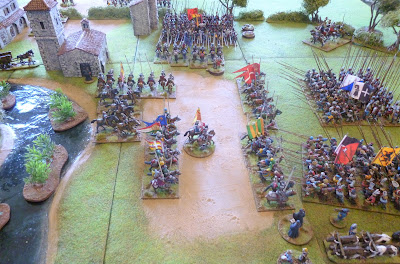 |
| The French heavy cavalry are holding their own against the Swiss. The Stradiots in the top right of the picture also remain a constant threat to the pike blocks and harass them with skirmish attacks. |
 |
| The fight between the cavalry and pike blocks is in full swing. |
 |
| Having fought with lancers, the Duke of Bouillon's gendarmes and Trémoille's men at arms the Gewalthut is finally broken and retreats from the field. |
 |
| With the larger Gewalthut gone and in the face of Trivulzio's gendarmes the smaller Nachhut is also stopped. |
 |
| . La Marck has advanced with the infantry but they have been unable to engage with the Swiss who are already retreating... |
 |
| ...he hasn't had to suffer any wounds in this clash or earned the nick name of "Le Jeune Adventureux" as he did in the historical battle. |
 |
| The Swiss arquebusiers have come under fire from the French artillery and the captain sounds a retreat for the Swiss forces. |
This was a really interesting game and Tom and I were both surprised with the result. We had wanted the surprise element of the Swiss attack to be a big factor in the game and this certainly proved to be the case! The Swiss focused purely on the French cavalry contingent instead of engaging with the landsknecht and artillery as they had done in the actual battle. This made the outcome of the battle radically different as the constant charges by the French gendarmes and men at arms combined with the skirmish attacks of the stradiots were sufficient to stop the pike blocks. This was in spite of the fact the Swiss pike blocks had so many "hits" and were so effective in combat.
If the supporting Swiss halberdier and arquebusier units had been able to close with the French, not to mention the "Foot Knight" Swiss captain unit and Sforza's gendarmes then the outcome would have be very different and the French cavalry would undoubtedly have been wiped out. I had won control of the Swiss support units on the second turn of the game and managed to deploy them all as far from my cavalry units as possible and this had a big impact as they were simply unable to get into action. When I commanded them I kept them inactive so I could deal with the pikes whilst when Tom got command of them they kept failing to activate! We decided that if we refought this we would change the rules so that each of the blocks, the Vorhut, Gewalthut and Nachhut, had specific units associated with them that would actually support them in the game. This would have made a big difference.
So in the end it was an overwhelming and very unhistorical victory for the French cavalry under Louis II de la Trémoille. The only person who had lived up to his performance in the real engagement was the Duke of Bouillon but instead of riding to rescue his son as happened at Novara, in this game it was his gendarmes who were the first to wild charge into the oncoming Swiss and sell themselves dearly in the process. The rules for the pike blocks were a lot of fun and despite the fact Tom's infantry never engaged we were both constantly involved in the game as we battled to control the Swiss units.
We will definiteley continue this "Renaissance Rampant" experimentation with the big pike formations. I love the look of the dense blocks of pikemen on the table and when the specific Reisläufer bases are mixed in with the landsknecht (which I need to do to make up the numbers of these huge blocks) the units still have a very Swiss feel to them under the Cantonal banners with all the white crosses and ostrich plumes. They made for a great game, very much full of surprises, and one fit for the 200th Camisado post. Now lets see if we can reach 300...


